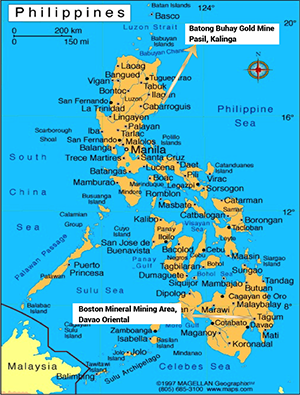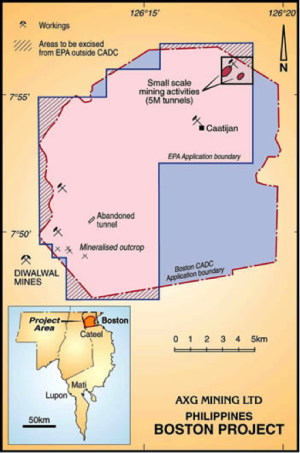
Geographical Map
DENR has defined several ore reserves in the Philippines. Bandoro Mining Inc., started to
acquire some mining operations in particular the Batong Buhay Gold Mine Site in Pasil, Kalinga Apayao and Boston Mineral Mining Area, in Davao Oriental, Mindanao. Other forthcoming projects soon to be announced.
Shown here are the determined mining locations with specific minerals that Bandoro Mining Inc., is now being operated.
Batong Buhay Gold Mine
Executive Summary
BATONG BUHAY GOLD MINES, INC. was established in 1934 as an underground gold mine with a 300 TPD-capacity mill in Pasil, Kalinga. World War II broke out and the mine was closed. In 1969 to 1970, exploration for disseminated copper was undertaken for BBGMI by Nippon Mining Company of Japan. In the period of 1977 to 1978, BBGMI itself drilled 17 exploration holes, after which the company had decided to develop the area’s porphyry copper deposit. In December 1979, the government, through the Development Bank
of the Philippines (DBP), took over the management, control and operation of BBGMI and appointed Philex Mining Corporation as its mining operator. The mine had produced 926,478 DMT at a mine head of 1.25% Cu for the year 1984 when it stopped operations because of insurgency problems. In June 1986, it was turned over to the Asset Privatization Trust (APT). Since then, the BBGMI property has been under the receivership of the government through its Privatization and Management Office (PMO) until is was transferred to Natural Resources Mining Development Corporation on April 7, 2006 for proper The Batong Buhay Copper-Gold Project is located at Barangay Balatoc, Municipality of Pasil, Kalinga-Apayao Province, Northern Luzon. It is within the eastern flanks of the Cordillera Central Range and is about 320 km North of Manila. It is bounded by geographic coordinates 17°20’41.2” to 17°22’07.7” latitude and 121°03’10.40” to 121°05’07.2” longitude with an area of 492 hectares.
II. GEOLOGY
The Batong Buhay is underlain by basalts, quartz diorite to tonalite porphyries and dacitic rocks. The basalts are generally propylitic but also exhibit localized advanced argilllic alteration near the intermediate intrusives and major structures. The northeast-trending quartz diorite-tonalite porphyries occur as mini-stocks intruding the basalts. The quartz diorite-tonalite porphyries are magnetite-chalcopyrite-bornite bearing with potassic alteration overprinted by sericite-day-chlorite alteration. The dacitic rocks are generally weakly phyllic-altered and shows localized advance argillic alteration near the intrusives.
The Dickson porphyry Cu-Au deposit has a high grade core with a diameter of 220 m and average assays of 1.43% Cu and 1.33 gpt Au, enveloped by an outer shell of 0.5% Cu. At the surface, the deposit shows primary chalcopyrite and secondary chalcocite+covellite+malachite mineralization. The Malinao orebody is roughly tabular in shape with dimensions of 800 m by 250 m. The primary copper mineral is chalcopyrite which is altered to secondary chalcocite, malachite and azurite.
Boston Minerals & Mining Corp.
Background
The Boston Minerals Mining Corporation gold Project area is situated in the Philippines Island of Mindanao in the province of Davao Oriental, town of Boston, which is 38 kilometers south of Bislig Town logging road locally known as M.5. The project area is approximately 338 hectares within the sitio of Napo Mining Village control area. The area is situated in the Davao-Agusan-Surigao Forest Reserve (Proclamation No. 369).
The gold rush area of Napo was discovered by small-scale miners in the early 90’s. Then Boston Minerals Mining Corporation acquired the rights on the area, but later assigned it to Sunlight Resources who conducted exploration on the area and conform the existence of the Ore body. There are more than 180 tunnels in the area being work by small-scale miners. So Sunshine had just conducted subsurface drilling to confirm the vertical depth of the deposit. In August 2000 Sunshine prematurely terminated its operation due to PICOP Resources Corporation opposition on the project. But Mr. Puyo who heads the Boston Minerals Mining Corporation continued in his quest to start the operation. In 2003, Mr. Puyo approached the right person to make feasibility study with a view to development of the Mine. During the stage of study small-scale miners further prove the ore bodies horizontally.
The Boston gold reserve is an epithermal gold deposit that is currently mined at the surface by small-scale miners producing gold in 180 tunnels. The mode of disposition is a low-sulfidization epithermal system. These modes of occurrence are the dominant gold producing areas in the Philippines. The development of the Boston gold ore body involves the designing of a pit for a medium tonnage operation. Evaluation work and pit design generated a stripping Ratio of 3.75:1 waste-ore ratio. However, the waste materials still contains from 0.40 to 1.00 grams gold content for which part of it could be recovered by heap leaking and pay off the cost of stripping. To minimized the capital outlay on mine equipment, all phases of earthmoving work, site preparation mill and other civil works considered in conjunction with the pit requirements.
To date Boston Minerals & Mining Corp., accord an exclusive operating agreement with Bandoro Mining Inc., to explore, mine, operate and market the ore being produced from the area.

Geographical & Geological Map
The Boston Project comprises three exploration tenement applications, which cover approximately 16,000 hectares in the Philippines. The tenements are bounded on the southwest by the Diwalwal gold rush area and located 120 kilometres north east of Davao on the island of Mindanao.
The Boston Project is a most attractive exploration area of a typical gold-mineralised epithermal system at the margin of a porphyry copper system. In epithermal systems, gold is concentrated in areas of dilation and a number of dilational areas coincidental with epithermal gold-bearing quartz veins in chemically altered rocks are obvious targets, as are gold-mineralized sulphide-rich breccias and silicified limestones. Early reconnaissance exploration at Boston has been extremely encouraging with high priority areas 5M, Beyangod Creek, Cababarunum Creek, Cabarobowanan Creek, Bidlo Creek and Dalikan containing mineralized epithermal vein systems in altered, dilated and fractured sequences..